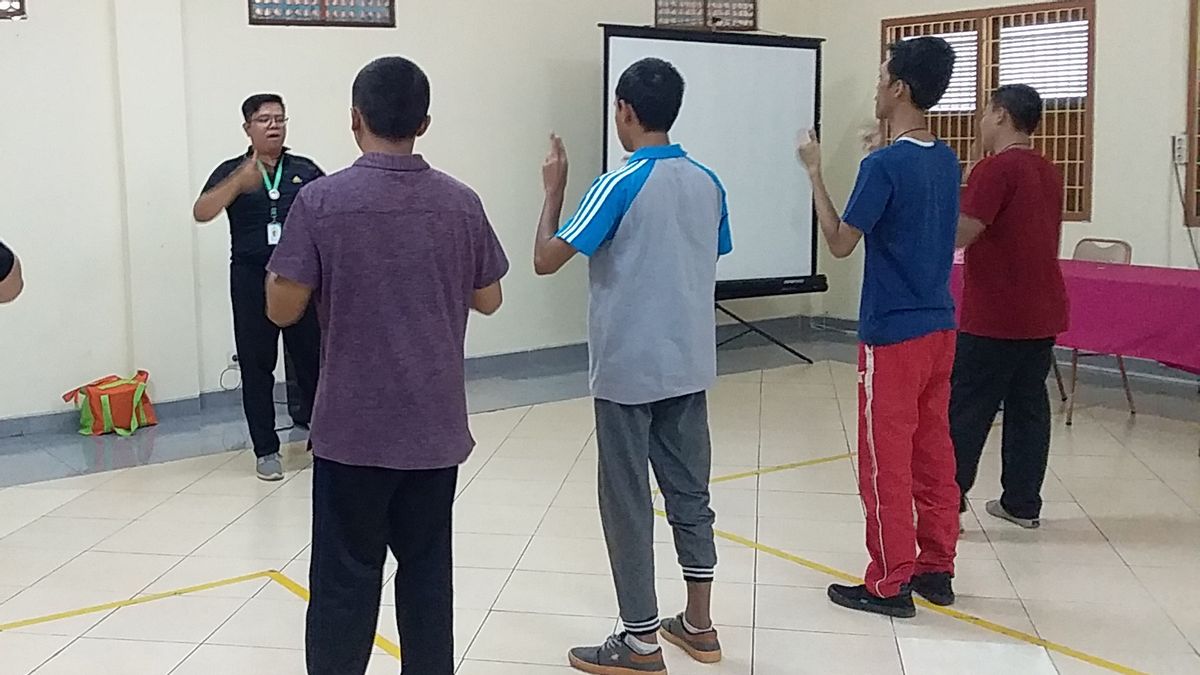JAKARTA - Talking about Jakarta, a few words must be implied in his head. One of them is 'jammed'. This is a condition experienced by almost all levels of society in the Capital City. Moreover, Jakarta also has a myriad of problems. Flood for example. So that people have to rack their brains to deal with existing problems.
With the problems in Jakarta that seem unsolved, of course it has a bad impact on society. Not only the material side, psychology also seemed attacked. The stress level in Jakarta has soared.
Stress, of course, will lead to mental disorders. Depression to what we often call 'crazy' is part of it. Many think that people with mental disorders are bad things. In fact, it is often seen as a disgrace to the family. Cases of shackling are often heard of in several areas.
Negative views towards people with psychiatric disorders arise from lack of information. Moreover, people only know that 'crazy' is a disease of people who are neglected and often roam the streets.
VOI tries to feel what some people find strange, namely being side by side with people with mental illnesses. Dr. Hospital Soeharto Heerdjan or better known as RSJ Grogol was the place we chose. Jakarta residents are certainly familiar with that place. Although they have never come to or seen, at least their ears have heard of it.
However, the majority of Jakartans consider mental hospitals to be taboo. Thus, its existence seems to be ignored.
Wednesday, December 18th, we choose it as a good day. Even though there is actually no correlation with our visit there. At that time, the sun hadn't been shining for long. Around 08.00 WIB to be exact.
Arriving at the hospital, we were accidentally greeted by a group of people who were neatly lined up while jogging. Right in front of the hospital entrance. They wore white sports uniforms with blue gradations. I don't know who they are.
Then we continued our journey. Park the vehicle and continue to meet with hospital officials. Of course, to get a coverage permit. After about half an hour of conversation with the President Director of the hospital, we were given permission to find out and feel our activities with people with mental disorders.
Honestly, we're relieved to be granted permission, but fear also envelops the heart. People who shout incoherently, chat alone, get angry for no reason make a picture in their mind; afraid to be their target.
The journey down the hospital begins. We are not alone, beautiful women wearing hijab accompany us to see and feel the activities of people with mental disorders. His name is Ananditya. To be closer, we called him Doctor Ana. He is the Head of the Psychosocial Rehabilitation Installation. We were invited to tour and interact with the patients there. Down the hall, the first place to go was the painting room.
In a large enough room with an area of about 15 meters, we were shown the paintings of the patients. Landscape images to abstract with various colors.

The question that we can think of is, how can they draw like that. Because, the paintings are quite good and eye-catching.
It's just that, after seeing the paintings one by one. We are focused on one image that is placed on top of the other paintings. There are only three colors in the painting, black, white, and a little brown. But that is not the reason why the painting attracts attention.
The picture in the painting is of a person who is sad. Tears clearly seen falling down the cheeks. As if there was something the painter felt. We also asked, who was the painting painter?
But that question was not answered. The reason is because the painter was no longer treated when Ana's doctor was working at the hospital. It's just that being said, painting is one method of knowing the patient's mood.
"Usually, when you are sad, the patient draws in dark colors. But on the other hand, if you like the color chosen brighter and the image itself is closer to the original object," said Ana.

The discussion about painting was quite exciting, but it was decided to move to another place. The great hall became his next destination. There, dozens of patients were seen sitting neatly. Their hands are folded on the long wooden table.
At first, we were afraid. It occurred to them that they would become the target of their anger. But it all goes away little by little. This is because what happened was not what we expected.
They were calmer and followed all directions from hospital officials. The context of the psychiatric patient is completely invisible. In fact, one of them absent his colleagues.
Realizing our astonishment, Doctor Ana smiled. He explained that the patient in the hall was a psychiatric patient who had more control over himself. With a little laugh, we replied, it was all beyond the expectations that had been previously expected.
However, curiosity is still in the heart. We asked to see other patients. Doctor Ana took us to a location called the inpatient ward. Both feet stepped. Follow the intended direction. The alley was winding. Until finally, there was a locked iron door right in front of us.
An officer was asked to open the iron door. The crossing has been welcomed. Left direction is the path we take. Then, our feet stepped back.
Five meters from the iron door, a ward or more similar to a room is visible. However, the different conditions were clearly visible. Iron bars surround the place. Apparently, this location is a rehabilitation place for people with mental disorders who are considered severe.
Severe context doesn't mean it can't be treated. More to patients who have just been treated and have just entered the observation stage. There were also many hospital officers accompanying the patients.
"There are 13 wards here, so we will mention them. Here also for patients we have to first assess," said Ana.
Unfortunately, we are prohibited from taking pictures at that location. The reason is, the patient's family is not pleased with it. So that the hospital must comply.
However, there is more to feel the situation that we previously thought. Some patients speak to themselves. In fact, there were male patients who were seen just standing in front of the iron fence. In addition, the patients at that location were also seen wearing clothes with matching colors, namely, blue shirts and white pants.
In the corner of the location, several male patients were also gathered. Three to four officers accompanied him. To be precise, they were undergoing a healing method. Honing and restoring the mindset of the patient is the goal.

We did not linger there, down the hall with white tiles back to be done. See one by one the activities of other patients. The kitchen was stopped. There were several patients who were taught to cook.
Cut carrots to potatoes, so a view. In fact, when we were observing their activity, there was one patient who turned his head towards us. Then, speak quickly with indistinct sentences.
Finally, the patient was asked to stop by Ana's doctor. "Yes, like that when you have a relapse. But we have to be patient to deal with it," he said.
Our visit is almost at the end of time. However, considering that the Christmas celebration will soon be welcoming, the hospital is also holding an event for patients. Unfortunately, we did not witness the event directly. However, it can be ascertained that it is all more about activities that hone the patient's abilities.
"There are many events, we make them like activities that have benefits for them. Besides of course the main goal is to commemorate Christmas for patients who celebrate it," said Ana.
Before leaving the hospital, we were invited to see a cafe. Nothing was different when you got there. You can see, four employees in gray uniforms combined with black aprons serve the customers.
Selling snacks and drinks did not change his general impression either. Until finally, a rehabilitation officer named Susi told them that they were former sufferers of psychiatric disorders.
Suddenly we were surprised. Because, there is no difference with ordinary people or normal people. "They used to be patients here. They can be said as patients who are cured or can control themselves and take care of themselves without the help of others," said Susi.
Working as a seller in a cafe is not without reason. It is also the final method of the rehabilitation phase in which they are held accountable for their work.
Moreover, they also have to interact with other people. So that periodically these patients will be assessed whether they are fit or can return to society.
Then we tried to talk with one of them. The young woman who had previously been a patient suffering from mental illness did not hesitate to interact with us. Starting from what he felt when he was suffering from the disease to the response about him in the eyes of the public, it was a topic of conversation.
He told us that when he was a patient, what he felt was the many voices in his ears. The voice ordered to do unreasonable things, such as getting angry and breaking or slamming things.
So we assume, if the patient is seen speaking alone it means that he is responding to the voices he hears.

"For me, I have a lot of noise in my ears. I'm also dizzy," he said, sitting on a wooden chair.
With red lipstick on her lips, this woman shamelessly said she was schizophrenic. In addition, the woman also shared her experiences while undergoing treatment in other places. There, he had experienced rough action. He never felt handcuffed to being hit with a belt.
In fact, he did not hesitate to show the scars he left behind as a result of the violence. Although he had time to tell his parents, no one seemed to believe his words.
"Nobody believes my story, but after my parents thought there might be a lot of scars on my body, they just realized," he said.
Five minutes passed, we finished the conversation. Until we realized, people with psychiatric disorders are not what they generally think.
The English, Chinese, Japanese, Arabic, and French versions are automatically generated by the AI. So there may still be inaccuracies in translating, please always see Indonesian as our main language. (system supported by DigitalSiber.id)












